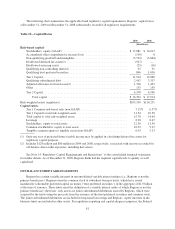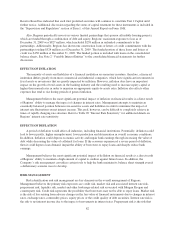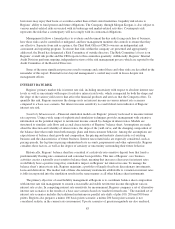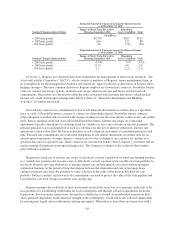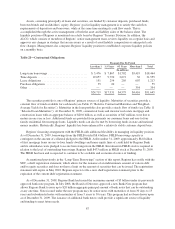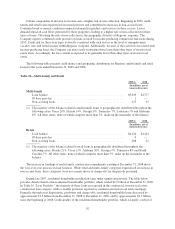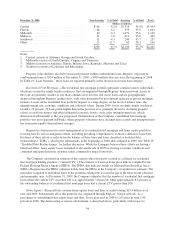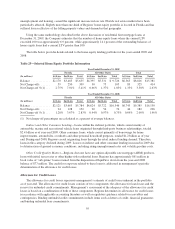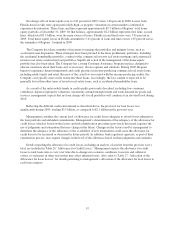Regions Bank 2009 Annual Report Download - page 102
Download and view the complete annual report
Please find page 102 of the 2009 Regions Bank annual report below. You can navigate through the pages in the report by either clicking on the pages listed below, or by using the keyword search tool below to find specific information within the annual report.At year-end 2009, based on assets available for collateral as of this date, Regions could have borrowed
either an additional $14.3 billion with terms of less than 29 days, or $11.5 billion with terms of greater than or
equal to 29 days, from the Federal Reserve Bank through its discount window and/or the TAF program. As of
December 31, 2009, Regions has no outstanding borrowings through the TAF and does not currently have any
plans to borrow again through the TAF program. However, the program is a short-term, inexpensive contingency
option for the Company. Future fundings under commitments to extend credit would increase Regions’
borrowing capacity under these programs.
Morgan Keegan maintains certain lines of credit with unaffiliated banks to manage liquidity in the ordinary
course of business. See Note 12 “Short-Term Borrowings” to the consolidated financial statements for further
details.
Representing possible future uses of liquidity, Regions may, from time to time, consider opportunistically
retiring our outstanding issued securities, including our subordinated debt, trust preferred securities and preferred
shares in privately negotiated or open market transactions for cash or common shares.
BROKERAGE AND MARKET MAKING ACTIVITY RISK
References below, and elsewhere in this Form 10-K, to “Morgan Keegan” are intended to include not only
Morgan Keegan & Company, Inc. but also certain of its affiliates and subsidiaries. You should not assume or
infer that any specific activity mentioned is carried on by any particular Morgan Keegan entity.
Morgan Keegan’s business activities, including its securities inventory positions and securities held for
investment, expose it to market risk. Morgan Keegan trades for its own account in corporate and tax-exempt
securities and U.S. Government agency and Government-sponsored securities. Most of these transactions are
entered into to facilitate the execution of customers’ orders to buy or sell these securities. In addition, it trades
certain equity securities in order to “make a market” in these securities. Morgan Keegan’s trading activities
require the commitment of capital. All principal transactions place the subsidiary’s capital at risk. Profits and
losses are dependent upon the skills of employees and market fluctuations. In order to mitigate the risks of
carrying inventory and as part of other normal brokerage activities, Morgan Keegan assumes short positions on
securities.
In the normal course of business, Morgan Keegan enters into underwriting and forward and future
commitments. At December 31, 2009, the contract amounts of futures contracts were $1 million to purchase and
$114 million to sell U.S. Government and municipal securities. Morgan Keegan typically settles its position by
entering into equal but opposite contracts and, as such, the contract amounts do not necessarily represent future
cash requirements. Settlement of the transactions relating to such commitments is not expected to have a material
effect on Regions’ consolidated financial position. Transactions involving future settlement give rise to market
risk, which represents the potential loss that can be caused by a change in the market value of a particular
financial instrument. Regions’ exposure to market risk is determined by a number of factors, including the size,
composition and diversification of positions held, the absolute and relative levels of interest rates, and market
volatility.
In the normal course of business, Morgan Keegan enters into transactions for delayed delivery,
to-be-announced securities, which are recorded in trading account assets on the consolidated balance sheets at
fair value. Risks arise from the possible inability of counterparties to meet the terms of their contracts and from
unfavorable changes in interest rates or the market values of the securities underlying the instruments. The credit
risk associated with these contracts is typically limited to the cost of replacing all contracts on which Morgan
Keegan has recorded an unrealized gain. For exchange-traded contracts, the clearing organization acts as the
counterparty to specific transactions and, therefore, bears the risk of delivery to and from counterparties.
88





